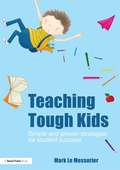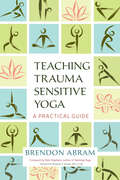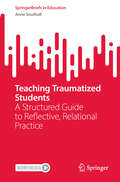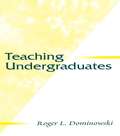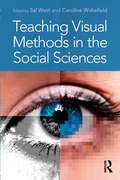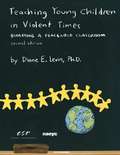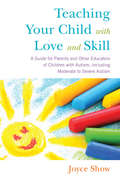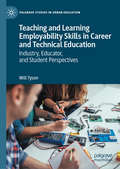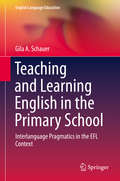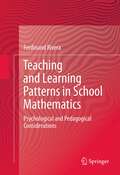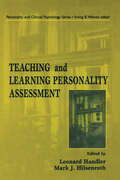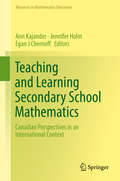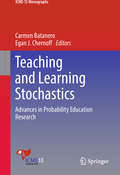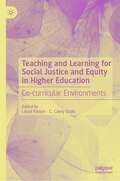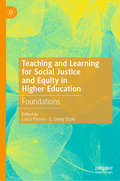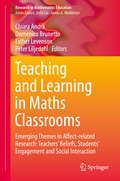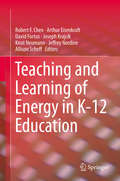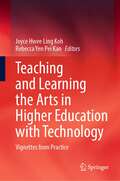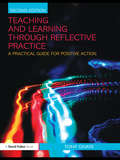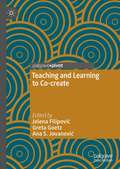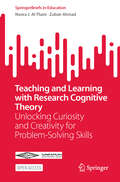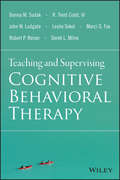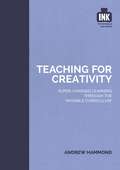- Table View
- List View
Teaching Tough Kids: Simple and Proven Strategies for Student Success
by Mark Le MessurierHow can you really make a difference for your students? Teaching Tough Kids delivers a refreshing collection of realistic ideas to sustain the organisational and behavioural transformations of all students, particularly those who 'do it tough'; who learn and react differently. They are complex kids who find life tougher than most. Managing their emotion and behaviour presents educators with a spectacular challenge in schools today, and numbers are on the rise. Filled with inspirational case studies, this book focuses on building improved relationships, structures and behaviours, rather than seeing the student as 'the problem' that must be fixed. Highlighting the value of promoting positive connections with students of all ages, the author presents ways to incorporate inclusive ideas into everyday practice and construct pathways for students to become engaged in their learning and achieve success. This stimulating book shows teachers how to: build student connectedness to learning; set achievable goals for each individual child; support emotional stability; strengthen organisation patterns; address behavioural issues; improve homework planning; create friendships and deal with bullying. Teaching Tough Kids takes a particularly close focus on students identified with Learning Disability, Attention Deficit Disorder, Attention Deficit Hyperactivity Disorder, Oppositional Defiant Disorder and Asperger Syndrome. Another group of students with executive functioning difficulties are emerging in schools. These are the kids who have endured neglect or too much stress and uncertainty in their lives and as a result display classic symptoms of hyperactivity, hyper vigilance and impulsivity. Teaching Tough Kids will be of immense interest to teachers, student teachers, staff in Pupil Referral Units, SENCos and all those involved with Behaviour Support work.
Teaching Trauma-Sensitive Yoga: A Practical Guide
by Mark Stephens Brendon Abram Margaret A. HowardA practical, hands-on, experienced-based guide from a military veteran turned yoga teacherBrendon Abram combines his first-hand experience with PTSD in the field and years of teaching to offer this practical guide to bringing trauma-sensitive yoga to both clinical and studio settings. Drawing on his work with military veterans, first responders, and survivors of domestic and sexual abuse, he emphasizes the importance of respecting the uniqueness of every individual and demonstrates how to use the foundational principles of yoga to create a safe experience. Abram explains that basic principles of yoga bring power to the practice and that breath, mindful movement, focused awareness, and acceptance of present-moment experience form the foundation of any yoga offering.
Teaching Traumatized Students: A Structured Guide to Reflective, Relational Practice (SpringerBriefs in Education)
by Anne SouthallThis book details an individualised approach to teaching traumatised students. While being trauma informed is an approach gaining interest in the field of education, frameworks that can respond to the individual nature of traumatic experience and explicitly describe responses that open pathways for learning remain a gap in the literature. This book describes a three-phase pedagogical framework to develop the relational and self-regulatory capacity of the student as a prerequisite for learning. It presents a staged approach which directs deep analysis and in-depth understanding of the impact of trauma for each student in their own school and classroom context. This book takes teachers through a step-by-step process which draws on current neuroscience and educator experience, to design intervention strategies that mitigate the impact of early childhood trauma on learning.
Teaching Undergraduates (Educational Psychology Series)
by Roger L. DominowskiThis practical guide is designed to help college teachers plan their undergraduate courses and deliver high-quality instruction. The book's theme is that teaching is a creative, decision-making, idea-testing enterprise whose purpose is to facilitate student learning in all of its facets. Its goal is to help instructors understand the multiple kinds of learning taking place in their courses so that they can select, devise, evaluate, and modify teaching techniques to improve their effectiveness. Based on research on human learning, memory, thinking, and problem solving, as well as studies of teaching and less-formal reports of teaching practices, the book offers concrete advice about all aspects of college teaching. *Part I is devoted to course planning. It outlines the many decisions instructors face in defining a course as their own and discusses the larger issues that shape a course and constrain some specific choices. Selecting course content, choosing learning goals, deciding how to pace a course, and scheduling tests are some of these issues. A workable timetable for preparing a course is included. *Part II is a mini-course on human learning, memory, and thinking. It provides the conceptual foundation for making teaching decisions, for selecting instructional strategies, and especially for inventing new techniques that might particularly fit a specific course. *Part III deals with the "nitty-gritty" of college teaching, including how to choose a textbook; lecturing and conducting classroom discussions; types and purposes of writing assignments, and how to structure and evaluate them; dealing with plagiarism; strengths and weaknesses of different types of tests, the relation of tests to learning goals, and guidelines for constructing good tests; and grading systems. *Part IV addresses professional and ethical issues of importance and consequence to instructors. New college instructors, more experienced faculty who would like to reflect on their teaching practices and consider making some changes, and teaching assistants will all find this book relevant and useful.
Teaching Visual Methods in the Social Sciences
by Caroline Wakefield Sal WattTeaching Visual Methods in the Social Sciences presents a practical and theoretical framework for those wanting to introduce visual methods into their curricula. Drawing on the expertise of contributors from across the social sciences, the book provides a comprehensive introduction to visual methodology, learning and teaching theory, and the ethical considerations involved. Divided into three parts, the book begins with an overview of how visual methods have been used in academic research, and how this can be applied to teaching and pedagogy. It then goes on to introduce different methods, including photography, film and drawing, describing how they can be used in various locations. Finally, the book pulls everything together, advocating the wider use of teaching visual methods in further and higher education curricula across the social science subjects. The book features a plethora of examples, as well as practical resources for FE and HE teachers, making it an essential companion for anyone interested in utilising visual methods in their teaching.
Teaching Young Children in Violent Times: Building a Peaceable Classroom (Second Edition)
by Diane E. LevinA required book for early childhood educators, parents, and policy makers as it helps teachers create a Peaceable Classroom, where children learn peaceful alternatives to the violent behaviors modeled for them in society. <P><P>This extensively revised and updated edition features new material for a post-September 11th world including a new chapter on helping children deal with violence in the news.
Teaching Your Child with Love and Skill: A Guide for Parents and Other Educators of Children with Autism, including Moderate to Severe Autism
by Joyce ShowParents of children with autism can often feel out of their depth when it comes to nurturing their child's learning and development. This book helps parents to make sense of the baffling array of educational interventions available, showing how to adapt different strategies to meet the specific needs of their child, including those with moderate to severe autism. Guided by love, faith and unwavering resolve, Joyce Show offers practical advice based on her experiences as both a mother and a physician. She takes the reader by the hand through all the steps of cognitive, social, and emotional development from initial engagement to abstract thinking, and provides straightforward primers for popular interventions such as Floortime and Applied Behavior Analysis (ABA). Parents will learn how to motivate play, build up communication, deal with challenging behaviors, and teach important everyday life skills, while growing in a trusting relationship with their child. This book offers encouragement and guidance to the parents of any child on the autism spectrum whether high or low functioning, as well as the teachers, therapists, family members, and friends who support them.
Teaching and Learning Employability Skills in Career and Technical Education: Industry, Educator, and Student Perspectives (Palgrave Studies in Urban Education)
by Will TysonThis book examines how industry-desired employability skills—or “soft skills”—are taught and learned in high school career and technical education (CTE) engineering and engineering technology programs. Identifying, recruiting, and keeping workers with strong personal and interpersonal skills is a constant challenge for STEM employers who need to hire young workers to replace an aging technical workforce. To answer the call, teachers interviewed explained that they maintain regimented daily classroom routines that include individual and small group hands-on activities and projects. In turn, their students explain learning personal responsibility, work ethic, teamwork, leadership, conflict management, and social skills in the classroom. Narratives from the workforce and classroom interweave to put employability skills frameworks into action.
Teaching and Learning English in the Primary School: Interlanguage Pragmatics in the EFL Context (English Language Education #18)
by Gila A. SchauerThis book is the first comprehensive investigation of interlanguage pragmatic issues in a primary school context that is based on both primary school teachers’ statements on their own teaching realities, views and preferences, and a thorough investigation of materials used by teachers and recommended by teacher educators in the state the primary schools are located in. It offers a contrastive analysis of primary school learners acquiring English in a typical English as a foreign language school context and their age peers in the same state that are exposed to English in a school immersion context. This book will be of interest to scholars, researchers, educators in higher education that focus on English language teaching, second language acquisition and applied linguistics. It is also intended for students who are planning to become primary school teachers of English as a foreign language.
Teaching and Learning Patterns in School Mathematics
by Ferdinand RiveraThis book synthesizes research findings on patterns in the last twenty years or so in order to argue for a theory of graded representations in pattern generalization. While research results drawn from investigations conducted with different age-level groups have sufficiently demonstrated varying shifts in structural awareness and competence, which influence the eventual shape of an intended generalization, such shifts, however, are not necessarily permanent due to other pertinent factors such as the complexity of patterning tasks. The book proposes an alternative view of pattern generalization, that is, one that is not about shifts or transition phases but graded depending on individual experiences with target patterns. The theory of graded representations involving pattern generalization offers a much more robust understanding of differences in patterning competence since it is sensitive to varying levels of entry into generalization. Empirical evidence will be provided to demonstrate this alternative view, which is drawn from the author's longitudinal work with elementary and middle school children, including several investigations conducted with preservice elementary majors. Two chapters of the book will be devoted to extending pattern generalization activity to arithmetic and algebraic learning of concepts and processes. The concluding chapter addresses the pedagogical significance of pattern learning in the school mathematics curriculum.
Teaching and Learning Personality Assessment
by Leonard Handler Mark J. HilsenrothHow do we move from an understanding of the administration, scoring, and interpretation of responses on various personality assessment instruments to the ability to put our understanding into words and communicate it effectively to referral agents and to patients themselves? And how do we transmit that ability to students? Teaching and Learning Personality Assessment strives to fill a gap in the literature and in many training programs. The editors have assembled a group of renowned clinicians, noted not only for their own acumen in personality assessment but also for their teaching talent, who present in detail time-tested techniques for teaching assessment. Readers have the opportunity to "sit beside" these seasoned mentors and learn their special skills. Numerous examples illustrate the key concepts. For every instructor of personality assessment who has ever pondered ways to organize a course or to convey difficult material, and for every student who has worried about how to translate theory into practice, in the context of a course or on his or her own, this book will offer enlightenment and provide uniquely practical assistance. It will be important reading for psychologists and trainees at every level of experience. Its clear style, vivid anecdotes, frank discussion of disagreements in the field, and innovative ideas make it an excellent text for both introductory and advanced courses.
Teaching and Learning Secondary School Mathematics: Canadian Perspectives in an International Context (Advances in Mathematics Education)
by Jennifer Holm Ann Kajander Egan J ChernoffThis volume brings together recent research and commentary in secondary school mathematics from a breadth of contemporary Canadian and International researchers and educators. It is both representative of mathematics education generally, as well as unique to the particular geography and culture of Canada. The chapters address topics of broad applicability such as technology in learning mathematics, recent interest in social justice contexts in the learning of mathematics, as well as Indigenous education. The voices of classroom practitioners, the group ultimately responsible for implementing this new vision of mathematics teaching and learning, are not forgotten. Each section includes a chapter written by a classroom teacher, making this volume unique in its approach. We have much to learn from one another, and this volume takes the stance that the development of a united vision, supported by both research and professional dialog, provides the first step.
Teaching and Learning Stochastics: Advances In Probability Education Research (ICME-13 Monographs)
by Carmen Batanero Egan J ChernoffThis book presents a collection of selected papers that represent the current variety of research on the teaching and learning of probability. The respective chapters address a diverse range of theoretical, empirical and practical aspects underpinning the teaching and learning of probability, curricular issues, probabilistic reasoning, misconceptions and biases, as well as their pedagogical implications. These chapters are divided into THREE main sections, dealing with: TEACHING PROBABILITY, STUDENTS' REASONING AND LEARNING AND EDUCATION OF TEACHERS.In brief, the papers presented here include research dealing with teachers and students at different levels and ages (from primary school to university) and address epistemological and curricular analysis, as well as the role of technology, simulations, language and visualisation in teaching and learning probability. As such, it offers essential information for teachers, researchers and curricular designers alike.
Teaching and Learning for Social Justice and Equity in Higher Education: Co-curricular Environments
by Laura Parson C. Casey OzakiThis book is the third in a four volume series that focuses on research-based teaching and learning practices that promote social justice and equity in higher education. In this volume, we focus on the application of the scholarship of teaching and learning in higher education outside of the classroom to maximize the effectiveness of student affairs programming. Specifically, authors focus on the application of SoTL in higher education outside of the classroom (e.g., faculty development, leadership, student involvement, student affairs) in ways that promote greater equity and inclusion in higher education. Each chapter includes a description of how higher education may traditionally marginalize students from underrepresented groups, outlines a research-based plan to improve student experiences, and provides a program or activity plan to implement the recommendations from each chapter.
Teaching and Learning for Social Justice and Equity in Higher Education: Foundations
by Laura Parson C. Casey OzakiThis book is the first of three edited volumes designed to reconceptualize teaching and learning in higher education through a critical lens, with this inaugural publication focusing on the fundamentals behind the experience. Chapter authors explore recent research on the cognitive science behind teaching and learning, dispel myths on the process, and provide updates to the application of traditional learning theories within the modern, diverse university. Through reviews of fundamental theories of teaching and learning, together with specific classroom practices, this volume applies social justice principles that have been traditionally seen as belonging to K-12 or adult education to higher education.
Teaching and Learning in Maths Classrooms: Emerging Themes in Affect-related Research: Teachers' Beliefs, Students' Engagement and Social Interaction (Research in Mathematics Education)
by Chiara Andrà, Domenico Brunetto, Esther Levenson and Peter LiljedahlThe book presents a selection of the most relevant talks given at the 21st MAVI conference, held at the Politecnico di Milano. The first section is dedicated to classroom practices and beliefs regarding those practices, taking a look at prospective or practicing teachers’ views of different practices such as decision-making, the roles of explanations, problem-solving, patterning, and the use of play. Of major interest to MAVI participants is the relationship between teachers’ professed beliefs and classroom practice, aspects that provide the focus of the second section. Three papers deal with teacher change, which is notoriously difficult, even when the teachers themselves are interested in changing their practice. In turn, the book’s third section centers on the undercurrents of teaching and learning mathematics, which can surface in various situations, causing tensions and inconsistencies. The last section of this book takes a look at emerging themes in affect-related research, with a particular focus on attitudes towards assessment. The book offers a valuable resource for all teachers and researchers working in this area.
Teaching and Learning of Energy in K - 12 Education
by Arthur Eisenkraft Robert F. Chen David Fortus Joseph Krajcik Knut Neumann Jeffrey Nordine Allison ScheffThis volume presents current thoughts, research, and findings that were presented at a summit focusing on energy as a cross-cutting concept in education, involving scientists, science education researchers and science educators from across the world. The chapters cover four key questions: what should students know about energy, what can we learn from research on teaching and learning about energy, what are the challenges we are currently facing in teaching students this knowledge, and what needs be done to meet these challenges in the future? Energy is one of the most important ideas in all of science and it is useful for predicting and explaining phenomena within every scientific discipline. The challenge for teachers is to respond to recent policies requiring them to teach not only about energy as a disciplinary idea but also about energy as an analytical framework that cuts across disciplines. Teaching energy as a crosscutting concept can equip a new generation of scientists and engineers to think about the latest cross-disciplinary problems, and it requires a new approach to the idea of energy. This book examines the latest challenges of K-12 teaching about energy, including how a comprehensive understanding of energy can be developed. The authors present innovative strategies for learning and teaching about energy, revealing overlapping and diverging views from scientists and science educators. The reader will discover investigations into the learning progression of energy, how understanding of energy can be examined, and proposals for future directions for work in this arena. Science teachers and educators, science education researchers and scientists themselves will all find the discussions and research presented in this book engaging and informative.
Teaching and Learning the Arts in Higher Education with Technology: Vignettes from Practice
by Joyce Hwee Ling Koh Rebecca Yen Pei KanThis book is an inquiry about the possibilities of using technology to support the education of artists within higher education contexts. Even though technology-enhanced learning and teaching may seem incongruent with the long-established studio-based cultures of making and performing, it is increasingly becoming a pivotal point to connect artistes to potential audience and markets. Amidst the COVID-19 pandemic, technology is also the crucial linchpin for educational continuity of student artists. This book explores how technology could enhance the education of artists and designers as they continue to create, make, and add value to life and society through their artistry. It draws upon the experiences of the Nanyang Academy of Fine Arts (NAFA), a pioneering arts institution in Singapore with over 80 years of institutional history. Through 9 vignettes, this book illustrates technology-enhanced pedagogical practices that have been implemented in different artistic learning spaces including classroom, studio, and stage as well as institutional support strategies. With a naturalistic stance, these chapters seek to illuminate realistic pictures of teaching and learning that are being uncovered by artist educators as they sought to integrate technology within teaching practices using available technologies and within the classes that they are teaching. It is hoped that this book will stimulate conversation among artist educators about possible pedagogical models, as well as inform higher arts institutions about the contextual strategies needed to support the creation of technology-enhanced pedagogical practices.
Teaching and Learning through Reflective Practice: A Practical Guide for Positive Action
by Tony GhayeNow in its second edition, Teaching and Learning through Reflective Practice is a practical guide to enable all those involved in educational activities to learn through the practices of reflection. The book highlights the power that those responsible for teaching and learning have to appraise, understand and positively transform their teaching. Seeing the teacher as a reflective learner, the book emphasises a strengths-based approach in which positivity, resilience, optimism and high performance can help invigorate teaching, enhance learning and allow the teacher to reach their full potential. This approach busts the myth that reflection on problems and deficits is the only way to better performance. The approach of this new edition is an ‘appreciative’ one. At its heart is the exploration and illustration of four reflective questions: What’s working well? What needs changing? What are we learning? Where do we go from here? With examples drawn from UK primary teacher education, the book reveals how appreciative reflective conversations can be initiated and sustained. It also sets out a range of practical processes for amplifying success. This book will be a must have for undergraduate and PGCE students on initial teacher training programmes. It will also interest practising teachers, teacher educators and those on continuing professional development courses.
Teaching and Learning to Co-create
by Jelena Filipović Greta Goetz Ana S. JovanovićThis edited book approaches the learning experience as a creative, constructive process from an epistemological orientation that combines transdisciplinary, participatory, and collaborative approaches to explore the most constructive ways forward for a networked constructivist (project- and problem-based) pedagogy. The volume emphasizes the value of a number of modes of inquiry that, among others, include ethnography, auto-ethnography, corpus analysis, narrative analysis, and their many intersections in the process of academic maturation and growth. This book will be of interest to applied linguists, sociolinguists, researchers, and educators of topics related to higher education and academic maturation, networked learning, qualitative inquiry and transdisciplinary studies.
Teaching and Learning with Research Cognitive Theory: Unlocking Curiosity and Creativity for Problem-Solving Skills (SpringerBriefs in Education)
by Zubair Ahmad Noora J. Al-ThaniThis open access volume explores the transformative role of Research Cognitive Theory (RCT) in education, emphasizing its application in fostering curiosity, creativity, innovation, problem-solving skills, and cognitive development across all educational levels in students and professional development in teachers. Through detailed discussions on integrating research-based learning with STEM education, the book offers practical insights for educators, researchers, and policymakers aiming to enhance teaching methodologies and student outcomes. By bridging the gap between theory and practice, this work serves as a vital resource for those seeking to cultivate inquiry-driven learning environments. Readers benefit from actionable strategies, case studies, and a comprehensive understanding of how RCT can revolutionize modern education.
Teaching and Measuring Cognitive Readiness
by Eva L Baker Ray S. Perez Harold F. O'NeilTeaching and Measuring Cognitive Readiness presents theoretical and empirical findings regarding cognitive readiness and assessments of their impact on adult learning. The term readiness is used in assessing student preparation for K-12 schools, while in the military and in industry, "readiness" denotes preparation to be effective in performing a mission or a job. Cognitive Readiness is viewed through a Knowledge, Skills, and Attributes (KSA) lens. Teaching and Measuring Cognitive Readiness deals with (a) the primacy of cognitive readiness as attributes or individual difference variables; (b) the need for cognitive readiness instructional and assessment strategies; (c) the need to integrate assessment into cognitive readiness training; (d) the need for theory-driven evaluation studies to increase knowledge and efficacy in teaching cognitive readiness; and (e) the need for a solid psychometric approach to the use of cognitive readiness assessments.
Teaching and Supervising Cognitive Behavioral Therapy
by Leslie Sokol Donna M. Sudak Derek L. Milne John W. Ludgate Robert P. Reiser R. Trent Codd III Marci G. FoxA total CBT training solution, with practical strategies for improving educational outcomes. Teaching and Supervising Cognitive Behavioral Therapy is the first comprehensive package to provide empirically-validated CBT training and supervisory techniques. Applicable to a variety of behavioral health care disciplines, this multi-modal guide provides educators with the information and tools that can help improve educational outcomes. An examination of CBT developments over the past twenty years leads into a discussion of practical applications for improving CBT education, while addressing the technological advances that facilitate dissemination and the specific challenges posed to confidentiality and patient care. The digital component contains additional audio and video content, plus downloadable worksheets that reinforce and expand upon the strategies presented. Coverage includes advice geared specifically toward the most commonly-encountered problems, with video of training sessions that address issues like frustration with patients, disbelief in psychotherapy, dislike of the method, and lack of skills. Readers will gain insight into effective goal setting, and implement a structured approach to supervision. Examine existing literature and research on training, supervision, and evaluation Integrate theory with practical strategies to improve learning outcomes Customize training approaches to specifically suit different professional groups Fit the methods to the environment, including workshops, webinars, and podcasts Mental health professionals who favor an empirically-based approach to therapy will appreciate the effectiveness of an empirically-based approach to pedagogy. Backed by over two decades of CBT research and the insight of leading CBT experts, Teaching and Supervising Cognitive Behavioral Therapy provides trainers with the tools and information they need to improve therapist educational outcomes.
Teaching for Creativity: Super-charged learning through 'The Invisible Curriculum'
by Andrew HammondThe Invisible Curriculum Series gives teachers the secret ingredients to unlock the full potential of children's learning abilities. Too often in formal schooling, creativity and curiosity are taught out of children. Teaching for Creativity offers practical advice on how to ensure that this does not happen. This book will help teachers to preserve children's innate creative capacities at the same time as maintaining academic standards in the classroom.
Teaching for Creativity: Super-charged learning through 'The Invisible Curriculum'
by Andrew HammondThe Invisible Curriculum Series gives teachers the secret ingredients to unlock the full potential of children's learning abilities. Too often in formal schooling, creativity and curiosity are taught out of children. Teaching for Creativity offers practical advice on how to ensure that this does not happen. This book will help teachers to preserve children's innate creative capacities at the same time as maintaining academic standards in the classroom.
